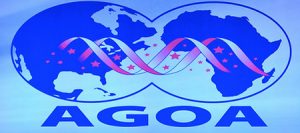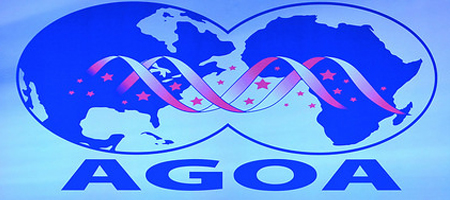AGOA: The U.S.-Africa Trade Program
 U.S. trade with sub-Saharan Africa has declined in recent years, prompting analysts to question the effectiveness of a preferential trade program for the region. Launched in 2000, AGOA is a preferential trade program that allows countries in sub-Saharan Africa to export products to the United States tariff-free. Many experts say the program has failed to live up to expectations, and the region’s exports to the United States have dipped below what they were when AGOA began
U.S. trade with sub-Saharan Africa has declined in recent years, prompting analysts to question the effectiveness of a preferential trade program for the region. Launched in 2000, AGOA is a preferential trade program that allows countries in sub-Saharan Africa to export products to the United States tariff-free. Many experts say the program has failed to live up to expectations, and the region’s exports to the United States have dipped below what they were when AGOA began
- Launched in 2000, AGOA is a preferential trade program that allows countries in sub-Saharan Africa to export products to the United States tariff-free.
- Many experts say the program has failed to live up to expectations, and the region’s exports to the United States have dipped below what they were when AGOA began.
- In 2022, the removal of several countries, including Ethiopia, from AGOA added to uncertainty about the program’s future.
The cornerstone of U.S. economic relations with sub-Saharan Africa since 2000 has been the African Growth and Opportunity Act, or AGOA. The program offers more than three dozen participants preferential access to U.S. markets by eliminating import tariffs.
Policymakers hoped that AGOA, as the primary U.S. trade policy for the region, would foster economic and political development in Africa. However, the outsize roles of oil and apparel in African export growth have raised questions about whether AGOA can diversify the region’s economies and increase its competitiveness in global markets. Moreover, after peaking in 2008, U.S. trade with AGOA’s participants has dropped to near its pre-AGOA total. Meanwhile, African trade relationships with other countries, particularly China, have greatly expanded.
Why was AGOA created?
AGOA is a trade preference program established in 2000 as part of broader legislation President Bill Clinton enacted to strengthen U.S. trade ties with Africa and the Caribbean. The act is unilateral, meaning it does not require African countries to lower their own barriers to U.S. goods, though it encourages them to do so. President Clinton saw the policy as a way to boost growth and bolster democratic ideals across the continent. He also said it would strengthen the U.S. economy by opening markets with “hundreds of millions of potential consumers” to American producers.
The act is an extension of the Generalized System of Preferences, a U.S. trade preference system introduced in 1974 that allows more than one hundred countries, mostly low-income nations, to export many of their goods to the United States duty-free. AGOA goes even further, offering this access to more than six thousand products from its thirty-eight current participants. It also mandates the executive branch to increase U.S. development assistance to sub-Saharan African countries in areas including agriculture and HIV/AIDS prevention. It was set to expire in 2008 but has since been renewed four times.
Which countries take part in it?
Only sub-Saharan African countries are eligible to be beneficiaries of AGOA, and the legislation outlines requirements candidates must fulfill, such as upholding the rule of law and human rights and liberalizing their economies. However, U.S. presidents can disqualify countries at their discretion and have done so, citing reasons such as rights violations and protectionist policies. Participants graduate out of AGOA [PDF] if per capita gross national income reaches $12,535, the World Bank’s lower limit for high-income countries.
Of the forty-nine potential beneficiaries in the region, thirty-six countries currently take part. A dozen are currently suspended: Burundi, Cameroon, Guinea, Equatorial Guinea, Eritrea, Ethiopia, Mali, Mauritania, Somalia, South Sudan, Sudan, and Zimbabwe. The Seychelles graduated out of the program in 2017.
How has the program fared?
AGOA received strong bipartisan support early on, with policymakers and trade officials pointing to a spike in U.S. imports of African goods as proof of its success: in the decade after the program began, exports from AGOA countries to the United States nearly tripled, rising from $22 billion to $61 billion. In 2010, Rosa Whitaker, a former assistant U.S. trade representative for Africa, called AGOA a “phenomenal success,” saying it had created more than three hundred thousand jobs on the continent, while the nonprofit African Coalition for Trade estimated in 2012 that up to 1.3 million jobs [PDF] were created indirectly.
Some analysts say the program has also helped several African countries diversify their economies. For example, South Africa ramped up its automotive exports to the United States from $150 million in 2000 to a high of $2.2 billion in 2013. Apparel production also spiked, particularly in East Africa. The most AGOA-related jobs were generated in this sector, according to the Brookings Institution.
However, some experts say U.S.-Africa trade relations remain underdeveloped. After the initial jump, exports have fallen to near their 2000 level. Diversification has also lagged, with oil and gas dominating AGOA exports since 2001. South Africa contributes the majority of exports, at more than 56 percent in 2021. Additionally, less than 1 percent of imports to the United States in 2019 came from sub-Saharan Africa, a 56 percent decrease from 2000; by comparison, the region produced about 4 percent of China’s imports and roughly the same portion of those for the European Union (EU).
What are criticisms of the program?
Enthusiasm for AGOA among U.S. policymakers has flagged in recent years, with some analysts pointing out that AGOA participants’ exports have decreased—in 2016, exports were less than when the program started. Additionally, there are concerns about Africa’s continued dependence on low-value-added products and natural resources; few beneficiaries have moved into the value-added manufacturing the legislation hoped to spur.
International trade experts Witney Schneidman, Kate McNulty, and Natalie Dicharry point to the dominance of a handful of the program’s participants to argue that both the United States and many of its AGOA counterparts have failed to use the program effectively. Only eighteen AGOA participants have crafted national strategies for taking advantage of the program, they say.
CFR’s Michael Froman, the U.S. trade representative under President Barack Obama, has said that obstacles including corruption and poor infrastructure have hindered the competitiveness of African producers and limited the program’s success. Other experts say the program lacks provisions to help U.S. exporters and investors compete with their counterparts in Europe and elsewhere.
Additionally, AGOA does not include fast-growing sectors such as digital and financial services. In recent years, analysts have called on the United States to push for more private-sector investment to take advantage of the region’s economic growth, which was higher than the global average over the fifteen years after AGOA was implemented. However, sub-Saharan Africa has not bounced back from the pandemic-induced recession like other regions have, and the International Monetary Fund projects it will experience the slowest recovery.
How have other countries approached trade in Africa?
China-Africa trade has soared since 2000, with China surpassing the United States as the largest single trade partner in 2009. Chinese trade with the region reached an all-time high of over $250 billion in 2021 as Beijing exported pandemic-related supplies to many of its African partners. China maintains special trade and economic cooperation zones in several sub-Saharan countries, and its foreign direct investment (FDI) flows to Africa have steadily increased. Meanwhile, China has provided more than $150 billion in development loans to the continent since 2000, and all but a handful of sub-Saharan countries are part of China’s Belt and Road Initiative. Analysts have raised concerns, however, over the high levels of debt that some African countries have taken on as the result of Chinese financing. Chinese banks have offered various forms of debt relief, and amid the COVID-19 crisis, they suspended debt service on all bilateral loans as part of a Group of Twenty (G20) initiative.
The EU, another major trade partner, has signed economic agreements with regional blocs in western, eastern, and southern Africa in which both sides offer preferential treatment on tariffs for certain goods. It also has trade partnerships with more than a dozen individual countries, including Cameroon, Ghana, Madagascar, South Africa, and Zimbabwe, and negotiations of other regional deals are underway. Since the 2019 launch of the African Continental Free Trade Agreement (AfCFTA), a trade bloc consisting of nearly every African country, the EU has touted plans to eventually reach a continent-to-continent free trade agreement. Some analysts, however, say that bringing such a deal to fruition would require the bloc to remedy its asymmetrical trade relationships with African partners by evening the playing field and opening more of its protected markets.
India has expanded its presence in sub-Saharan Africa as well. Its trade with the region saw a more than tenfold increase from 2000 to 2019, reaching $56 billion, alongside surges in private investment in telecommunications, information technology, and energy.
What is the future of AGOA?
AGOA was last renewed in 2015 and is set to expire in 2025, though U.S. Trade Representative Katherine Tai has so far signaled that her office will try to improve upon the existing program as Congress considers AGOA’s future.
In early 2022, the United States removed Ethiopia, Guinea, and Mali from AGOA, citing human rights abuses and military coups in violation of the program’s rules. While Guinea and Mali send less than 1 percent of their exports to the United States, Ethiopia relies heavily on AGOA’s benefits to support its textile industry. The Joe Biden administration has emphasized that the countries can be readmitted if they return to compliance, but experts say the expulsion could push the countries to strengthen trade ties with other powers; some Ethiopian business leaders, for instance, have argued in favor of moving closer to China, given Beijing’s no-strings-attached approach to investment.
At its inception, AGOA was widely viewed as a first step toward permanent free trade agreements (FTAs), which would provide additional certainty for investors by locking in trade benefits. However, Washington has not concluded any FTAs with sub-Saharan African countries. Although it held negotiations [PDF] with the members of the Southern African Customs Union—Botswana, Eswatini (formerly Swaziland), Lesotho, Namibia, and South Africa—those fell through in 2006, in part due to disagreements over intellectual property rights and foreign investment rules. Under President Donald Trump, the United States began drafting an FTA with Kenya, but the deal is currently on hold while the Biden administration reviews U.S. trade policy. Biden has also sought to revamp the Trump-era Prosper Africa initiative, which aims to boost trade and investment with the continent.
The AfCFTA could also play a major role in AGOA’s path forward. Proponents say the agreement, signed by all of the African Union’s fifty-five member states except Eritrea, will boost regional trade by forming a single market and that it will create millions of jobs across the continent. In light of this, some analysts have suggested that Washington should use AfCFTA as the foundation for talks to create a new strategic economic partnership rather than renewing AGOA.




















